|
  |
|
Page 2 |
Newsletter 131 Winter 2020 © Hampshire Mills Group |
Fallgate Mill
Ruth and Keith Andrews
|
|
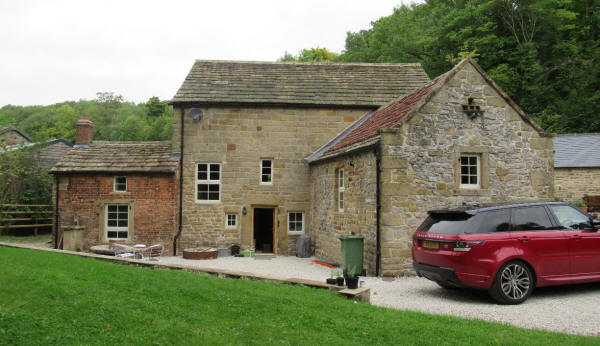
|
|
The
buildings of Fallgate Mill (also known as Fall Mill)
at SK 354623 probably date from the early 17th
century and have been restored, with a lot of
internal gearing still intact. There were two wheels
at opposite ends of the main building, one of which
has been ‘restored’. The position of the other wheel
is detectable from score marks on the mill wall and
a filled-in aperture for the axle. Originally water
was brought to the mill through a long leat from a
weir on the River Amber about half a mile upstream.
There was a mill pond, now filled in, above the
site, and some water probably also came from a lead
mine sough.
|
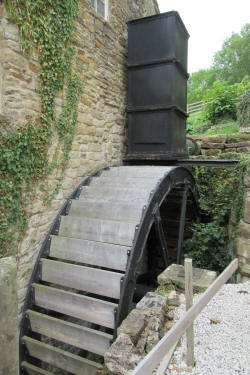 |
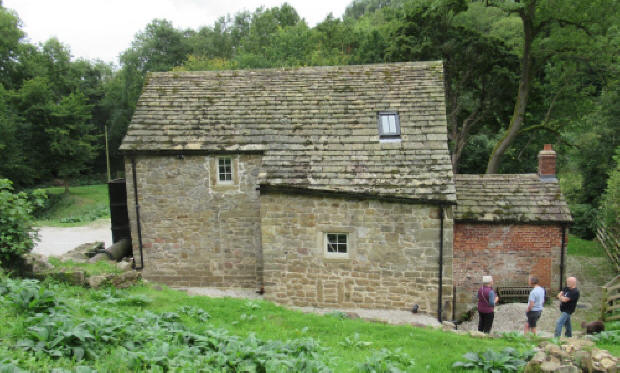 |
|
In
1918 the site was acquired by the Clay Cross Company
who used the mill for grinding fluorspar. In 1925 a
siding from the Ashover Light Railway was laid to
run in front of the buildings. The mill continued to
be used until the 1950s and then fell into
disrepair. It was the last of seven that worked in
the Amber Valley.
In
1985 the site was taken on by Ashover Parish Council
and some restoration work was carried out; more work
has been done recently prior to the conversion and
sale of the building as a residence.
Information from Derbyshire Historic Environment
Record
https://her.derbyshire.gov.uk/Monument/MDR5136
Fallgate Mill and the Clay Cross Company
The Clay Cross Company, founded (at Clay Cross!
south of Chesterfield) in 1837 by George Stephenson,
produced lime for roadstone, concrete, and so on.
|
|
In
1919 the Overton Estate near Ashover was purchased
for its valuable mineral deposits, especially
limestone and fluorspar, and a quarry was opened at
Fallgate. The Ashover Light Railway was constructed
to link the quarry to the Clay Cross works. A
steam-powered electricity generating station (‘power
house’) was built next to the mill in 1924 to
provide power for the quarry. A siding from the
railway served the mill and power house.
|
|
Fluorspar, composed of calcium and fluorine (CaF2),
is used in a wide variety of chemical,
metallurgical, and ceramic processes. and was
generally ground at a large plant south of the
quarry (see map). Some customers required it more
finely ground, and this was done at Fallgate Mill.
It was dried by a gas-fired kiln (which replaced a
coke-fired one) in the red pantiled front part of
the mill, and then ground using the water-powered
millstones, and loaded into wagons on the siding to
be shipped out. At least one of these millstones is
embedded in the kitchen floor.
|
|
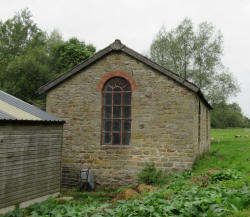
The power house, built with materials
from demolished buildings on the same site, with
large cast iron windows.
TInformation from
The Ashover Light Railway,
by
R Gratton and S R Band,
(Wild Swan, 1989)
|
|
So here are some interior details.

|
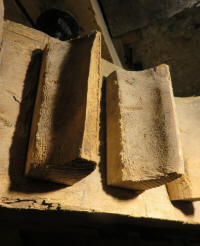
(Above) Details of wear on the teeth
of the great spur wheel and wallower
|
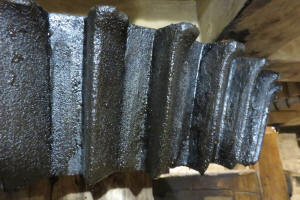
(Right) The kitchen
floor has recently been relaid using worn out
millstones. The nearer one must have been used for
grinding fluorspar.
|
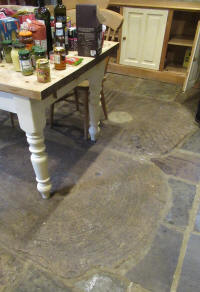 |
|
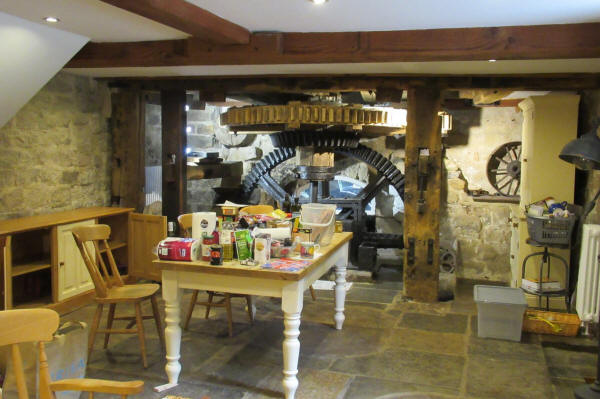
|
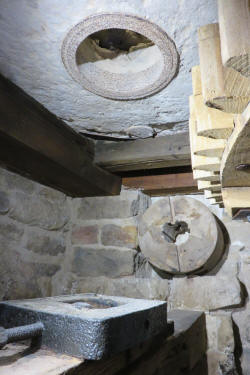 |
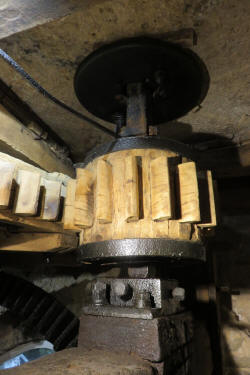 |
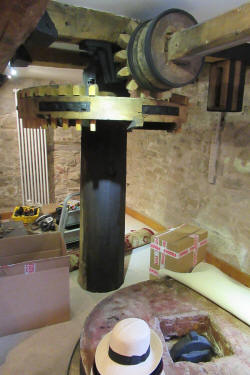 |
|
(Above left) At first
glance, this is a bedstone, but it is actually an
upside down runner stone, which at present is
letting a cold draught into the living room
upstairs.
(Centre and right)
The restored stone spindle looks OK, but the stones
above it are clearly not a matching pair. Also the
layshaft and the crown wheel have been heavily
‘restored’ and fossilised by being cemented into the
wall.
|
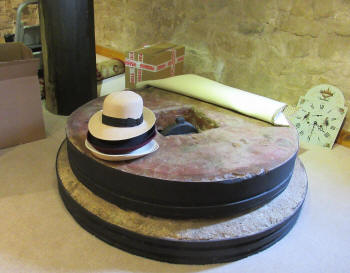 |
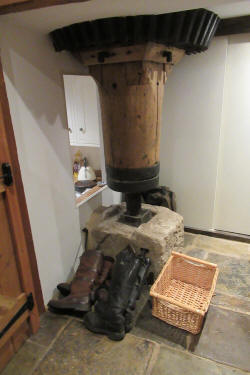 |
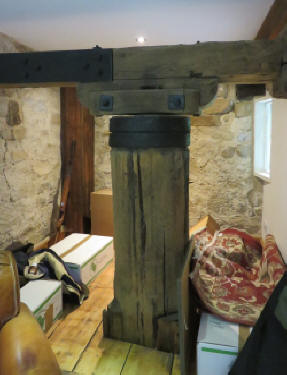 |
So
much restoration work has been carried out a various
times that it is hard to see what the stones were
like when they were in use.
At
the other end of the building the missing waterwheel
drove an upright shaft, which is still in place
along with its wallower. This is the only part of
the machinery remaining on that side of the mill.
|
|
Externally there are also interesting features, and
quite a lot of work to be done.
The
cosmetically restored waterwheel needs some remedial
work. At present the penstock is not attached to
either its supports (which appear to be railway
track) or the building, and has a lot of wood in its
construction. Also, the new wooden bucket boards are
too short, and the sole plate is completely missing,
although its bolts are clearly visible.
|
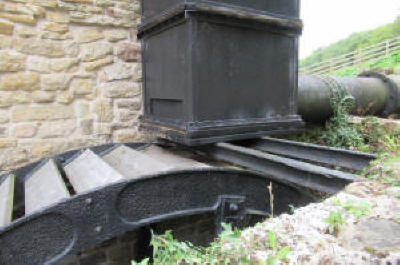 |
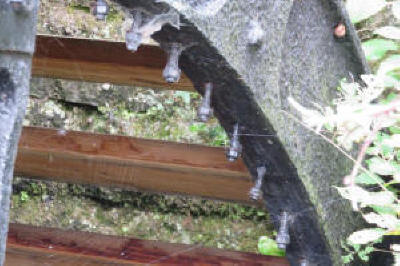 |
|
The
easiest immediate task will be to fit a new guard
rail around the wheel pit.
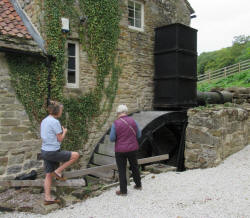
|
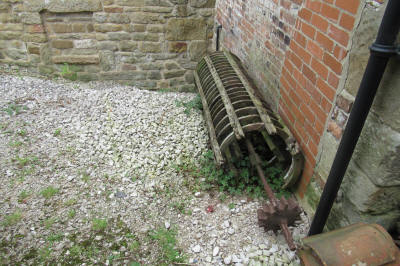
There are various other
interesting artefacts around like this wire machine,
which is on the site of the other wheel pit (note
the axle hole); also outside are a number of
millstones and part of an axle bearing. |
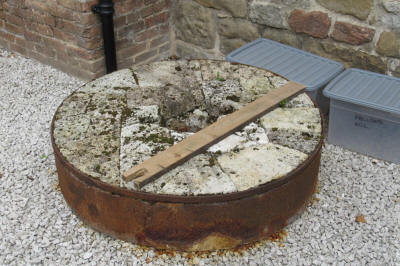 |
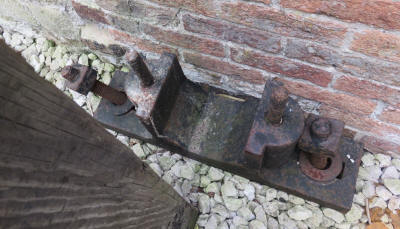 |
|
I’m
sure several people reading this are already
dreaming of a work party! Ruth and Michael bravely
said anyone is welcome to visit; you can contact
them through me. Finally I am very grateful to them
for freely giving us access to their new home and
spending so long showing us round – while they
should really have been continuing to move in and
doing more unpacking!
|
  |
|
|
